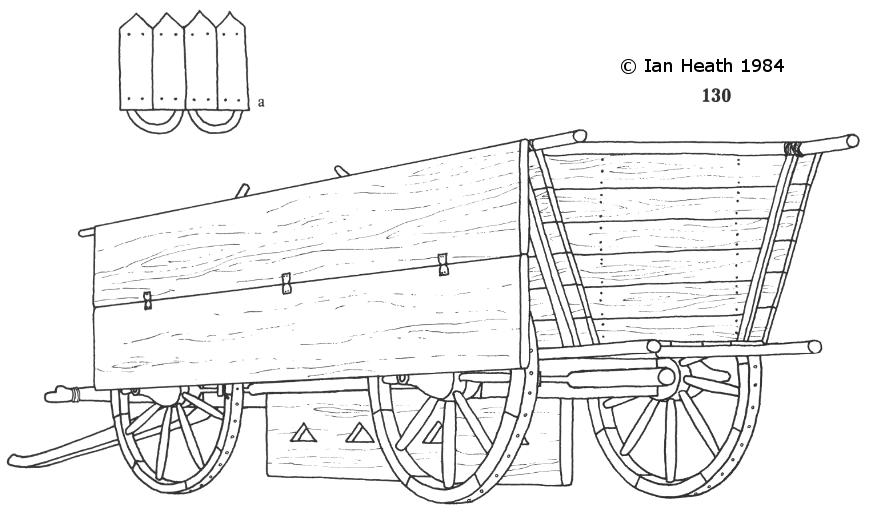Find the perfect fit with Amazon Prime. Try Before You Buy.

Join Amazon Prime - Watch Thousands of Movies & TV Shows Anytime - Start Free Trial Now
HUSSITE WAR-WAGON c.1430
An extract from Armies of the Middle Ages, Volume 2
by Ian Heath

[Based on a Hussite Wagon Fortress, Johannes Hartlieb: 'Kriegsbuch', 1437]
130. HUSSITE WAR-WAGON c.1430
When the Hussite wars began in 1419 ordinary peasant wagons were used albeit undoubtedly strengthened where possible but as time went by special war-wagons were developed,
reinforced with wooden hoardings and iron or steel cladding. That illustrated here is based on contemporary sources and modern-day Czech reconstructions.
It has a hinged, folding hoarding for added protection on the side facing the enemy (130a shows an alternative type of hoarding from a German ms.),
plus a thick plank pierced with loopholes suspended beneath the wagon (removed when on the march).
The side of the wagon behind the hoarding was further reinforced by a trough of stones,
also used for throwing; the British Museum ms. shows a Hussite soldier throwing a rock from a wagon by hand, and Hussite boys were trained to use the sling and staff-sling.
The other side of the wagon included a drawbridge-like ramp which permitted its crew ease of access and egress in action.
When fully developed, Hussite wagons contained all sorts of tools and equipment, contemporary records listing 2 axes, 2 spades, 2 pickaxes, 2 hoes, 2 shovels, lances with hooks,
plus a long chain with hook and ring for coupling the wagons together in battle.
In addition each wagon also carried a movable wooden mantlet that was used to fill the gaps between wagons when they were drawn up in laager.
Each wagon was drawn by 4, later 4-8, horses.
Hungarian war-wagons would have undoubtedly been virtually, if not absolutely, identical to those described above,
since it was probably under Bohemian influence that the Hungarians began to assign a more important battlefield role to their own wagons during the 1440s.
The Germans too adopted war-wagons from the Bohemians, even fielding them against the Hussites in 1427, though with a notable lack of success.
In Austria in 1433 Brocquière was shown wagons 'which the Duke of Austria had constructed to combat the Bohemians.'
Those he saw could carry 20 men like the Hussite wagons, though his guide assured him that there was one that could hold 300 men but still needed only 18 horses to draw it!
Next: 131. GERMAN WAR-WAGON c.1480 in Armies of the Middle Ages, Volume 2 by Ian Heath
Back to the contents for Extracts from Armies of the Middle Ages, Volume 2 by Ian Heath


